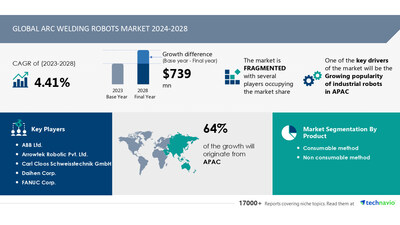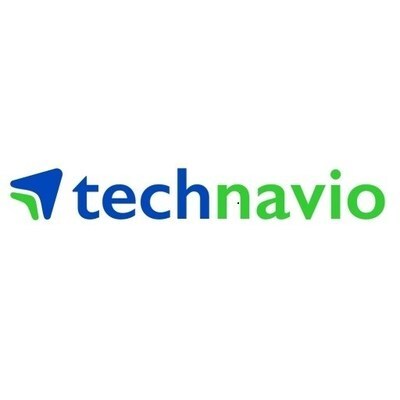Arc Welding Robots Market size is set to grow by USD 739 million from 2024-2028, Growing popularity of industrial robots in APAC boost the market, Technavio
PR Newswire
NEW YORK, June 9, 2024
NEW YORK, June 9, 2024 /PRNewswire/ -- The global arc welding robots market size is estimated to grow by USD 739 million from 2024-2028, according to Technavio. The market is estimated to grow at a CAGR of over 4.41% during the forecast period. Growing popularity of industrial robots in APAC is driving market growth, with a trend towards adoption of innovative business models. However, operational challenges associated with welding robots poses a challenge. Key market players include ABB Ltd., Arrowtek Robotic Pvt. Ltd., Carl Cloos Schweisstechnik GmbH, Daihen Corp., FANUC Corp., Hyundai Motor Co., igm Robotersysteme AG, Kawasaki Heavy Industries Ltd., Kemppi Oy, MIDEA Group Co. Ltd., Miller Electric Manufacturing Co., NACHI FUJIKOSHI Corp., Panasonic Holdings Corp., Shanghai Genius Industrial Co. Ltd., SRDR Robotics, Staubli International AG, Stellantis NV, Teradyne Inc., The Lincoln Electric Co., and Yaskawa Electric Corp..
Get a detailed analysis on regions, market segments, customer landscape, and companies- View the snapshot of this report
Arc Welding Robots Market Scope | |
Report Coverage | Details |
Base year | 2023 |
Historic period | 2018 - 2022 |
Forecast period | 2024-2028 |
Growth momentum & CAGR | Accelerate at a CAGR of 4.41% |
Market growth 2024-2028 | USD 739 million |
Market structure | Fragmented |
YoY growth 2022-2023 (%) | 4.16 |
Regional analysis | APAC, Europe, North America, |
Performing market contribution | APAC at 64% |
Key countries | China, Japan, US, Germany, and UK |
Key companies profiled | ABB Ltd., Arrowtek Robotic Pvt. Ltd., Carl Cloos |
Market Driver
Rental companies like Hirebotics, Tokyo Century, and ORIX are transforming the arc welding robots market by offering flexible solutions for end-users. These firms provide robot deployment plans, programming support, maintenance, and repair services. They help install robots, peripherals, and manufacturing machinery as a single unit. End-users can rent robots with the latest technologies for a monthly cost between USD1,300 and USD1,800, with no upfront asset allocation.
Rental companies cover installation expenses and offer industry-specific solutions. Key vendors like ABB Ltd. and FANUC Corp. provide refurbished robots through subsidiaries like Robot Worx. The trend towards robot rentals is driven by the high initial cost of ownership and the challenges of designing and implementing industrial robots independently. Businesses can achieve significant ROI by renting robotic automation, leading to market growth during the forecast period. However, this trend may negatively impact key vendors' revenues due to decreased demand for new arc welding robots. New robots like KR Cyber tech's nano ARC HW edition offer various payloads and installation options, catering to diverse industries.
The consancy growth in the manufacturing sector has led to an increased demand for productivity and efficiency in various production processes. One such process is arc welding, where robots have emerged as a key trend. These robots, equipped with advanced features like precision, speed, and consistency, are used in sectors such as automotive, aerospace, and construction. The market for arc welding robots is expanding, with companies focusing on automation and cost reduction.
Factors like the availability of skilled labor and the need for high-quality output are driving the adoption of these robots. Additionally, the use of technologies like artificial intelligence and machine learning is expected to further enhance the capabilities of arc welding robots. Overall, the market for arc welding robots is poised for significant growth in the coming years.
Research report provides comprehensive data on impact of trend. For more details- Download a Sample Report
Market Challenges
- The arc welding robots market faces operational challenges, including inconsistent welding due to poor fixtures and metal forming variations. For small batch sizes, high-speed tool changing is necessary, but manual welding outperforms robots in this regard. Programming robots for batch manufacturing or repair work takes significant time, with offline programming offering a solution.
- However, the predominant use of teach pendants results in extended downtime. Welding in confined spaces remains a challenge, limiting the market in certain end-user segments. These operational issues are major hurdles for the global arc welding robots market during the forecast period.
- The Arc Welding Robots Market faces several challenges. One major challenge is the high cost of implementation, including the cost of robots, automation equipment, and installation. Another challenge is the need for skilled labor to operate and maintain the robots.
- Additionally, the integration of these robots with existing manufacturing systems can be complex and time-consuming. Furthermore, the lack of standardization in robot programming languages and interfaces can hinder interoperability and increase costs. Lastly, the need for continuous improvement and upgrades to keep up with technological advancements can add to the overall cost and complexity of the system.
For more insights on driver and challenges - Request a sample report!
Segment Overview
- Product
- 1.1 Consumable method
- 1.2 Non consumable method
- Application
- 2.1 Automotive
- 2.2 Electricals and electronics
- 2.3 Aerospace and defense
- 2.4 Others
- Geography
- 3.1 APAC
- 3.2 Europe
- 3.3 North America
- 3.4 South America
- 3.5 Middle East and Africa
1.1 Consumable method- The arc welding robots market encompasses various consumable methods, including SMAW (stick metal arc welding), GMAW (gas metal arc welding), FCAW (flux-cored arc welding), and SAW (submerged-arc welding). SMAW, also known as stick welding, is a versatile and cost-effective method preferred in metal, shipbuilding, and construction industries. GMAW, or MIG welding, is the most used method with robots due to its high welding speed and extensive applications in repairing and reassembling automotive parts.
FCAW offers benefits such as rust tolerance, high deposition, and simplified operation, making it an alternative to SMAW for welding steel and nickel alloys. SAW is suitable for carbon and low-alloy steel and is expected to witness slow growth during the forecast period. The increasing demand for robust metal parts in industries like defense, automotive, and manufacturing has led to a significant market growth for arc welding robots.
For more information on market segmentation with geographical analysis including forecast (2024-2028) and historic data (2017-2021) - Download a Sample Report
Research Analysis
The Arc Welding Robots Market is experiencing significant growth in the automotive and transportation sector due to the rapid industrialization and the increasing demand for high-quality welds with consistency, higher production rates, and improved performance. IIoT, cyber-physical systems, cloud robotics, and cloud computing are transforming the manufacturing industry by enabling real-time data processing and analysis, leading to zero down time and increased automation.
Metal inert gas (MIG) and Tungsten inert gas (TIG) welding processes are commonly used in the production of metal components. Sensors, vision systems, and controls are essential components of arc welding robots, ensuring accuracy and repeatability in the welding process. The market is expected to continue its upward trend, driven by the need for higher speeds and improved overall efficiency in automotive manufacture.
Market Research Overview
The Arc Welding Robots Market encompasses a wide range of automated welding systems designed to improve productivity, consistency, and safety in various industries. These robots utilize advanced technologies such as programmable controllers, sensors, and manipulators to execute welding processes with precision and efficiency.
The market is driven by factors including increasing demand for automation in manufacturing, growing adoption of robotic welding in the automotive sector, and the need for high-quality welds in infrastructure projects. Additionally, advancements in robotics technology, such as collaborative robots and 3D printing, are expanding the applications and capabilities of arc welding robots. The market is expected to continue growing due to these trends and the ongoing digitalization of industries.
Table of Contents:
1 Executive Summary
2 Market Landscape
3 Market Sizing
4 Historic Market Size
5 Five Forces Analysis
6 Market Segmentation
- Product
- Consumable Method
- Non Consumable Method
- Application
- Automotive
- Electricals And Electronics
- Aerospace And Defense
- Others
- Geography
- APAC
- Europe
- North America
- South America
- Middle East And Africa
7 Customer Landscape
8 Geographic Landscape
9 Drivers, Challenges, and Trends
10 Company Landscape
11 Company Analysis
12 Appendix
About Technavio
Technavio is a leading global technology research and advisory company. Their research and analysis focuses on emerging market trends and provides actionable insights to help businesses identify market opportunities and develop effective strategies to optimize their market positions.
With over 500 specialized analysts, Technavio's report library consists of more than 17,000 reports and counting, covering 800 technologies, spanning across 50 countries. Their client base consists of enterprises of all sizes, including more than 100 Fortune 500 companies. This growing client base relies on Technavio's comprehensive coverage, extensive research, and actionable market insights to identify opportunities in existing and potential markets and assess their competitive positions within changing market scenarios.
Contacts
Technavio Research
Jesse Maida
Media & Marketing Executive
US: +1 844 364 1100
UK: +44 203 893 3200
Email: media@technavio.com
Website: www.technavio.com/
![]() View original content to download multimedia:https://www.prnewswire.com/news-releases/arc-welding-robots-market-size-is-set-to-grow-by-usd-739-million-from-2024-2028-growing-popularity-of-industrial-robots-in-apac-boost-the-market-technavio-302167732.html
View original content to download multimedia:https://www.prnewswire.com/news-releases/arc-welding-robots-market-size-is-set-to-grow-by-usd-739-million-from-2024-2028-growing-popularity-of-industrial-robots-in-apac-boost-the-market-technavio-302167732.html
SOURCE Technavio




